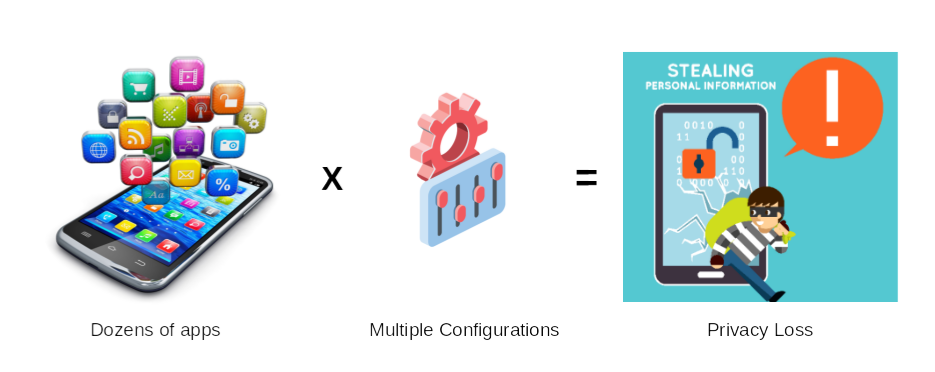My research interests are in the area of security and privacy of computer and communication systems, with application areas such as wireless networks, Internet of Things and mobile devices. More specific research topics include: wireless physical-layer security, security of next-generation networks, privacy-preserving data mining, location privacy, and automated privacy protection.
1. Automated Privacy Protection for Mobile Devices
The pervasiveness of mobile devices with always connected users fostered applications that rely on user data to provide personalized services. However, privacy risks arise from the continuous access and collection of user data, that is sometimes sold and/or shared with third parties, e.g. through data brokers. One of the underlying issues is with the lack of awareness and control of users with respect to the privacy settings of mobile devices.

The multitude of apps and privacy configurations make it unfeasible to finely control all privacy settings. In particular in a field-study [1] we observed an average of 836 permission requests per day (around 35 per hour), thus making it impractical to manually answer all requests. Therefore, current approaches rely on a paradigm where generally permissions are asked upon first use, but automatically granted on all subsequent requests. This is, however, a suboptimal privacy approach, that leads to 15% of privacy violations [1].

It is well known that users trade privacy for small benefits (e.g. "free" services). This calls for mechanisms that empower users with greater control and awareness over their data.
Our work addresses this issue through the development of mechanisms for automated privacy protection. For example, prediction of privacy preferences allows to reduce the number of privacy violations [2]. Such prediction can also be performed in a distributed / federated manner [3], thus enabling prediction of privacy decisions without access to user data.
Part of this work was performed in the scope of the NGI-TRUST project COP-MODE and the MIT-Portugal project SNOB5G.
Related references:
[1] R. Mendes, A. Brandao, J.P. Vilela, A.R. Beresford, Effect of User Expectation on Mobile App Privacy: A Field Study, International Conference on Pervasive Computing and Communications (PerCom), 2022![]()
![]()
[2] R. Mendes, M. Cunha, J.P. Vilela, A. Beresford, Enhancing User Privacy in Mobile Devices Through Prediction of Privacy Preferences, European Symposium on Research in Computer Security (ESORICS), 2022![]()
[3] A. Brandao, R. Mendes, J.P. Vilela, Prediction of Mobile App Privacy Preferences with User Profiles via Federated Learning, ACM Conference on Data and Application Security and Privacy (CODASPY), 2022![]()
2. Location Privacy
- On the Effect of Update Frequency on Geo-Indistinguishability of Mobility Traces, R. Mendes, J.P. Vilela, ACM Conference on Security and Privacy in Wireless and Mobile Networks (WiSec), 2018.

- Clustering Geo-Indistinguishability for Privacy of Continuous Location Traces, M. Cunha, R. Mendes, J.P. Vilela, IEEE International Conference on Computing Communication and Security, 2019

- Impact of Frequency of Location Reports on the Privacy Level of Geo-indistinguishability, R.Mendes, M.Cunha, J.P.Vilela, Proceedings on Privacy Enhancing Technologies, 2020.


3. Physical-layer Security
Jamming for Secrecy:
- Friendly Jamming for Wireless Secrecy, J.P. Vilela, M. Bloch, J. Barros and S.W. McLaughlin, IEEE International Conference on Communications (ICC 2010), Cape Town, South Africa,May 2010.

- Jammer Selection Policies for Secure Wireless Networks, J.P. Vilela, P.C. Pinto, J. Barros, IEEE ICC 2011 Workshop on Physical-Layer Security, Kyoto, Japan, June 2011.

- Wireless Secrecy Regions with Friendly Jamming, J.P. Vilela, M. Bloch, J. Barros and S.W. McLaughlin, IEEE Transactions on Information Forensics and Security, June 2011.

- Position-based Jamming for Enhanced Wireless Secrecy, J.P. Vilela, P.C. Pinto, and J. Barros, IEEE Transactions on Information Forensics and Security, Sept. 2011.

- A Cooperative Protocol for Jamming Eavesdroppers in Wireless Networks, J.P. Vilela, J. Barros, IEEE International Conference on Communications (ICC 2012), Ottawa, Canada, June 2012.

- Collision-free Jamming for Enhanced Wireless Secrecy, J.P. Vilela, J. Barros, IEEE International Workshop on Data Security and Privacy in Wireless Networks (D-SPAN), Madrid, June 2013.

- A Characterization of Uncoordinated Frequency Hopping for Wireless Secrecy,
J.S. Sousa, J.P. Vilela, IEEE/IFIP Wireless and Mobile Networking Conference, Vilamoura, Portugal, May 2014.

- Uncoordinated Frequency Hopping for Secrecy with Broadband Jammers and Eavesdroppers,
J.S. Sousa, J.P. Vilela, IEEE International Conference on Communications, London, UK, June 2015.

- Physical-layer Security Against Non-degraded Eavesdroppers, J.P. Vilela, J.S. Sousa, IEEE Global Communications Conference, San Diego, CA, USA, December 2015.

- Uncoordinated Frequency Hopping for Wireless Secrecy Against Non-degraded Eavesdroppers, J.S. Sousa, J.P. Vilela, IEEE Transactions on Information Forensics and Security, 2018.

- Exploiting the Reciprocal Channel for Discrete Jamming to Secure Wireless Communications against Multiple-Antenna Eavesdropper, G.Anjos, D.Castanheira, A.Silva, A.Gameiro, M.Gomes, J.Vilela, IEEE Access 2018.

- Full-Duplex Jamming for Enhanced Hidden-Key Secrecy, Z. Dryer, A. Nickerl, M. Gomes, J.P. Vilela, W.K. Harrison,IEEE International Conference on Communications, 2019

- SDR Testbed of Full-Duplex Jamming for Secrecy, A. Silva, M. Gomes, J.P. Vilela, W.K. Harrison, IEEE/IET International Symposium on Communication Systems, Networks and Digital Signal Processing, 2020

- SDR Proof-of-Concept of Full-Duplex Jamming for Enhanced Physical Layer Security, A. Silva, M. Gomes, J.P.Vilela, W.K.Harrison, Sensors, 2021.

Coding and Modulation for Secrecy:
- Interleaved Coding for Secrecy with a Hidden Key, D. Sarmento, J.P. Vilela, W.K. Harrison, M. Gomes, IEEE Globecom Workshop on Trusted Communications with Physical Layer Security, San Diego, CA, USA, December 2015.

- Interleaved Concatenated Coding for Secrecy in the Finite Blocklength Regime, J.P.Vilela, M.Gomes, W.K.Harrison, D.Sarmento, F.Dias, IEEE Signal Processing Letters, 2016.

- Joint Design of Massive MIMO Precoder and Security Scheme for Multiuser Scenarios under Reciprocal Channel Conditions, G.Anjos, D.Castanheira, A.Silva, A.Gameiro, M.Gomes, J.P.Vilela, Wiley Wireless Communications and Mobile Computing, 2017.

- Nested QPSK Encoding for Information Theoretic Security, G.T. Rendon, W.K. Harrison, M. Gomes, J.P. Vilela, IEEE International Conference on Communications, 2018.

- Testbed Implementation and Evaluation of Interleaved and Scrambled Coding for Physical-Layer Security, C. Martins, T. Fernandes, M. Gomes, J.P. Vilela, IEEE Vehicular Technology Conference - Spring, 2018.

- Analysis of Short Blocklength Codes for Secrecy, W.K.Harrison, D.Sarmento, J.P.Vilela, M.Gomes, EURASIP Journal on Wireless Communications and Networking 2018.

- Adaptive Physical-Layer Security through Punctured Coding for Secrecy, M. Carreira, T. Monteiro, M. Gomes, J.P. Vilela, W.K. Harrison, IEEE International Conference on Communications, 2019

- Polar Coding for Physical-layer Security without Knowledge of the Eavesdropper's Channel, T. Monteiro, M. Gomes, J.P. Vilela, W.K. Harrison, IEEE Vehicular Technology Conference-Spring, 2019

- Irregular Quadrature Amplitude Modulation for Adaptive Physical-layer Security, H. Searle, M. Gomes, J.P. Vilela, W.K. Harrison, IEEE Global Communications Conference, 2019

- Generating a Binary Symmetric Channel for Wiretap Codes, W.K.Harrison, T.Fernandes, M.Gomes, J.P.Vilela, IEEE Transactions on Information Forensics and Security, 2019.

- Implications of Coding Layers on Physical-Layer Security: A Secrecy Benefit Approach, W.K.Harrison, E.Beard, S.Dye, E.Holmes, K.Nelson, M.Gomes, J.P.Vilela, Entropy - Special Issue Information-Theoretic Security II, 2019.

- Keyed Polar Coding for Physical-Layer Security without Channel State Information, T. Pinto, M. Gomes, J.P. Vilela, W.K. Harrison, IEEE International Conference on Communications, 2021


- On the Secure Spectral Efficiency of URLLC with Randomly Located Colluding Eavesdroppers, J. Farhat, G. Brante, R.D. Souza, J.P. Vilela, IEEE Internet of Things Journal, 2021.

4. Other Networking Security (Ad-hoc Networks, Network Coding, Cloud, IoT, SDN)
- A Cooperative Security Scheme for Optimized Link State Routing in Mobile Ad-hoc Networks,
J.P. Vilela and J. Barros, 15th IST Mobile and Wireless Communications Summit, Mykonos, Greece, June 2006.

- Evaluating the Overhead of a Cooperative Security Scheme for Optimized Link State Routing, J.P. Vilela and J. Barros, 3rd International Workshop on Mathematical Techniques and Problems in Telecommunications, Leiria, Portugal, Sept. 2006.
- A Feedback Reputation Mechanism to Secure the Optimized Link State Routing Protocol,
J.P. Vilela and J. Barros, IEEE/CreateNet International Conference on Security and Privacy in
Communication Networks (SecureComm), Nice, France, September 2007.

- Lightweight Security for Network Coding,
J.P. Vilela, L. Lima and J. Barros, IEEE International Conference on Communications (ICC 2008), Beijing, China, May 2008.

- An Information-Theoretic Cryptanalysis of Network Coding - is protecting the code enough?, L. Lima, J.P. Vilela, J. Barros and M. Medard, International Symposium on Information Theory and its Applications (ISITA), Auckland, New Zealand, Dec. 2008.
- Security and privacy issues for the network of the future, G.F. Marias, J.Barros, Ma.Fiedler, An.Fischer, Ha. Hauff, R. Herkenhoener, A. Grillo, A. Lentini, L. Lima, C. Lorentzen, W. Mazurczyk, H. de Meer, P.F. Oliveira, G.C. Polyzos, E. Pujol, K. Szczypiorski, J.P. Vilela, T.T.V. Vinhoza, Wiley Security and Communication Networks, 2011.
- Expedite Feature Extraction for Enhanced Cloud Anomaly Detection, B. Dalmazo, J.P. Vilela, P. Simoes, M. Curado, IEEE/IFIP NOMS Workshop on Security for Emerging Distributed Network Technologies (DISSECT), Istambul, Turkey, April 2016.

- Triple-Similarity Mechanism for Alarm Management in the Cloud, B.L.Dalmazo, J.P.Vilela, M.Curado, Elsevier Computers & Security 2018.

- Blockchain-based Scalable Authentication for IoT, M. Mukhandi, E. Andrade, F. Damião, J. Granjal, J.P. Vilela, ACM Sensys, 2020

- A Security Gateway for Power Distribution Systems in Open Networks, E. Andrade, J. Granjal, J.P. Vilela, C. Arantes, Elsevier Computers & Security, 2021.

- CROCUS: An objective approach for SDN controllers security assessment, C. Silva, B. Sousa, J.P. Vilela, EAI SecureComm, 2021

- Bringing Network Coding into SDN: Architectural Study for Meshed Heterogeneous Communications, A. Cohen, H. Esfahanizadeh, et al., IEEE Communications Magazine, 2021.
